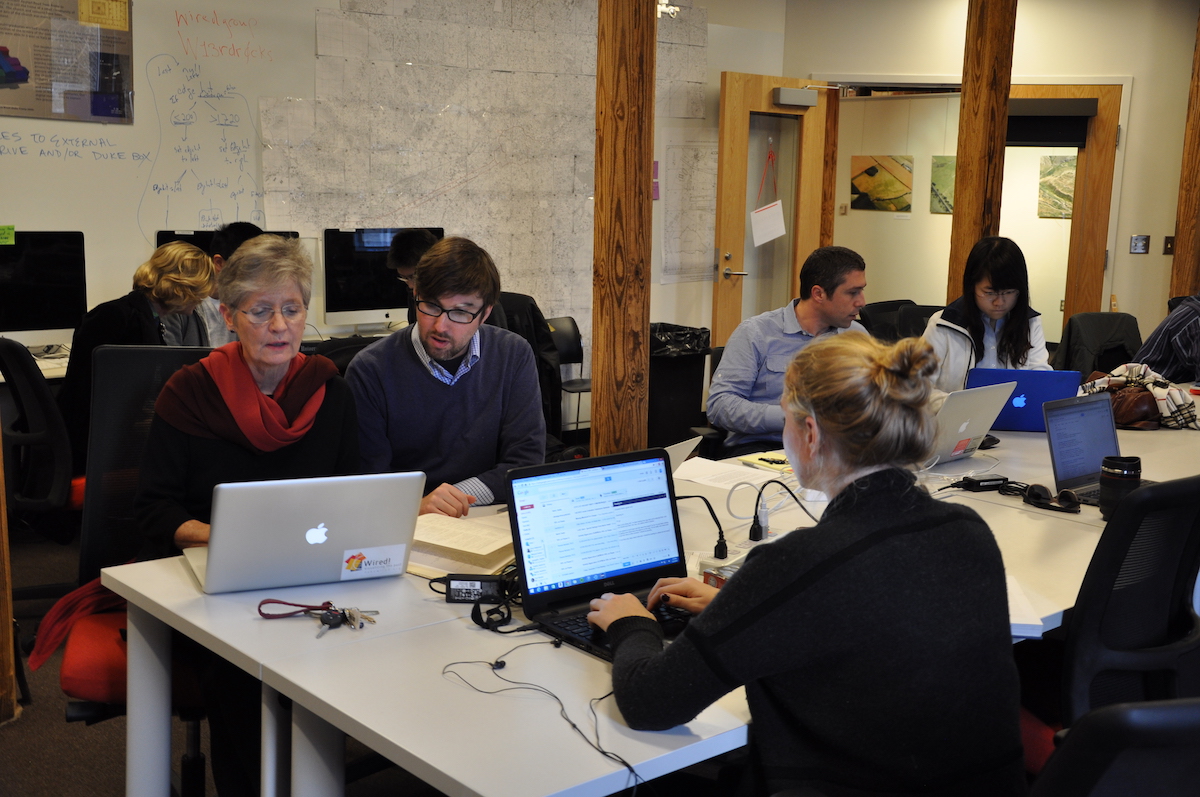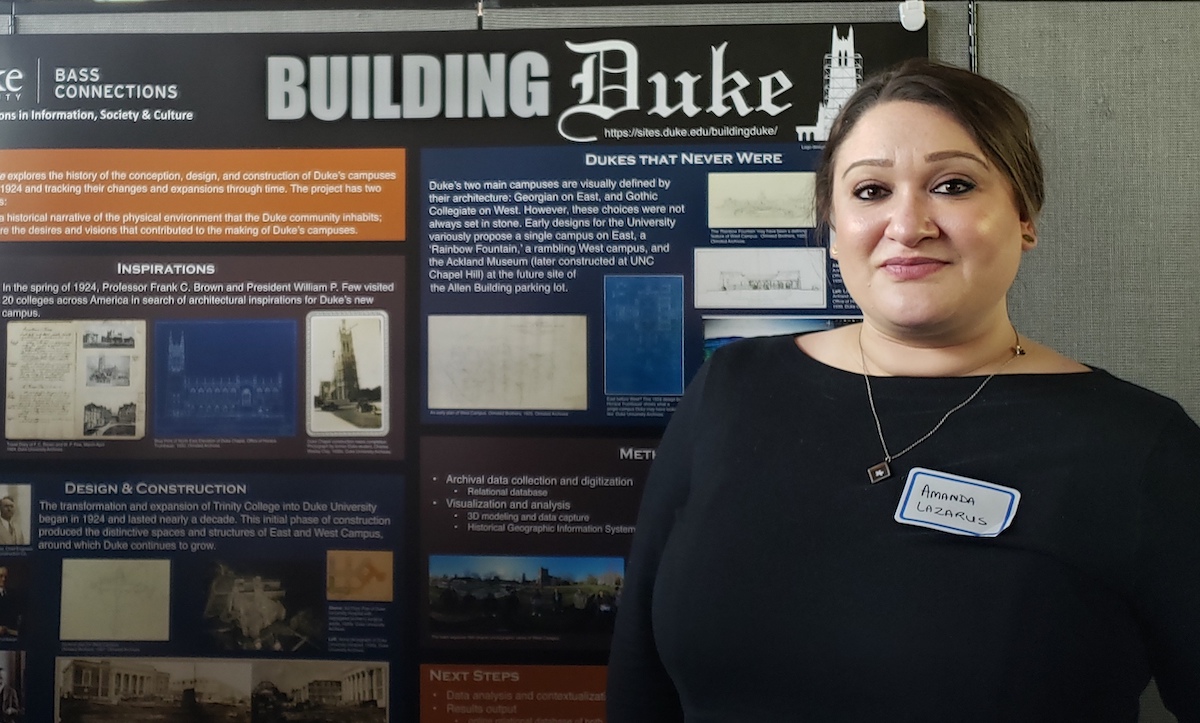PhD Students in the Wired! Lab
- Sheila Dillon
Since the lab’s inception, graduate students have been an important part of Wired!. They can serve as co-PIs of various research projects, as project managers, or as research team members who also function as mentors to undergraduate participants following a vertically integrated model of teaching and scholarship (see A New Lab Model for Art History & Visual Culture and Collaborative Teaching). Many of these graduate students have gone on to write dissertations that incorporate visualization techniques that they learned in the lab. Some even developed their own research projects and recruited student teams to realize them (e.g. Statues Speak, Elizabeth Baltes, PhD 2016). Not only do the graduate students of Wired! learn visualization software, strategies, and methods that they can then deploy in their own research, but they also gain experience in project management, collaborative research, and teaching.
In addition to participating in research teams, graduate students who have worked in the Wired! Lab can further develop the visualization skills they have learned by serving as teaching assistants for undergraduate courses, which have increasingly incorporated Digital Humanities projects in their curriculum. These teaching assistants are mentored by the lab’s Digital Humanities Specialist, Hannah L. Jacobs, and lab faculty. For example, as a Digital Humanities TA for the courses VMS 89S Visual Culture of Venice and ARTHIST 255 Art in Renaissance Italy, Nikos Gkiokas helped students with their ArcGIS Story Maps and Omeka/Neatline projects. He also led a workshop on Neatline for ARTHIST 184D History of Pre-Modern Architecture. In a different context as the Wired! TA for the Friday open lab meetings, Felipe Alvarez de Toledo developed a resource for humanists to learn the Python programming language. As a TA for another iteration of VMS 89S Visual Culture of Venice, he taught students how to use Omeka for developing digital research collections and Neatline for visualizing this information in time and space. These Digital Humanities teaching opportunities allow graduate students to diversify and enhance their teaching portfolios, and to document in tangible ways the broad range of skills they develop during their graduate career.
In the words of Amanda Lazarus (PhD Candidate in Art History):
The Wired! Lab has played a pivotal role in my education and professional development at Duke, as it has allowed me to explore new and inspiring approaches to art historical and Digital Humanities research, pedagogy, and collaboration. Having access to and being part of this intellectual community has shown me a different way to be an art historian. Being trained on digital platforms such as Omeka, Neatline, and Airtable has changed the way I approach my research on ancient Greek sculpture and how I present my arguments, while the vertically integrated structure of Wired! research teams has provided me with a rich environment for intellectual and creative collaboration.
As a graduate member of the Wired! Lab, I have participated in several projects: Digital Athens, Paris of Waters, and Building Duke. Each has afforded me the opportunity to perform novel research on a variety of topics in Art and Architectural History. In my role of project manager for Building Duke, under the direction of project leaders Sara Galletti, Kristin L. Huffman, and Hannah L. Jacobs, my contributions have focused on mentorship, research, and project outcomes. As the team continues to research and analyze the architectural history of Duke University, I work closely with undergraduate students, training them in digital tools, archival and secondary-source research, and data cataloguing and management. I also help develop intra- and interinstitutional research relationships, and perform research on the university’s landscape architecture.
Other graduate student testimonials also speak to this diversity of professional and intellectual experience. For example, Elizabeth Baltes (PhD 2016) states:
As a graduate student, I was part of the inaugural Wired! course in 2009, as well as several long-term research projects in the Wired! Lab. I never imagined how these experiences would change the trajectory of my research and career. The kinds of digital reconstruction technologies I learned in the Wired! Lab reframed my approach to the material culture of ancient Greece by allowing me to visualize—and question—the ways built landscapes have changed over time. Now a faculty member at Coastal Carolina University, I remain an active member of this vibrant learning community and an advocate for the critical use of digital tools in the service of Humanities research.
In a similar vein, Tim Shea (PhD 2018) reports:
My time in the Wired! Lab was the highlight of my Duke graduate experience. It is hard to replicate the intellectual stimulation and sense of discovery that collaborative work in a place like Wired! generates. Some of my most impactful teaching and learning experiences took place in the lab. My role as project manager of the Digital Athens project was to train students in the fundamentals of GIS through a regular series of tutorials. Our aim was to map the remains of the ancient city of Athens uncovered in large-scale, formal excavations and small rescue excavations throughout the city through georeferenced excavation plans and aerial photography and vector data of the locations of archaeological features.
When I started working in the Wired! Lab, I was considering several possible dissertation topics, but I had yet to finalize my research plan. I went into the Digital Athens project with an open mind and a desire to learn new digital research methods. One of the first tasks that we undertook was to map the find locations of tombstones uncovered in rescue excavations across the city. We began experimenting with GIS and other database platforms, and soon, I had mapped all of the tombstones excavated in the East Cemetery of ancient Athens. This dataset became the foundation of my dissertation research. I fleshed out the dataset to include information from the inscriptions on tombstones, such as whether the deceased was a citizen or immigrant and, if the latter, where they migrated from. I demonstrated that immigrant communities were buried together within the ancient city of Athens and that each group had different preferences for tombstone types that gave each cemetery of Athens its own particular character and appearance. My exposure to digital research methods in the Wired! Lab not only made it possible for me to draw the conclusions I did in my dissertation, but it shaped the very questions that I thought to ask.
Banner Image: Map showing Nazi forced labor construction sites around Kraków. Map created by Antonio LoPiano

